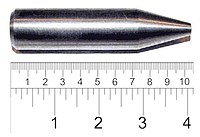
Photo from wikipedia
Aflatoxins (AFs) are mycotoxins produced by Aspergillus parasiticus and Aspergillus flavus which frequently contaminate maize. These compounds are considered toxic, especially AFB1 which has been classified as a human carcinogen,… Click to show full abstract
Aflatoxins (AFs) are mycotoxins produced by Aspergillus parasiticus and Aspergillus flavus which frequently contaminate maize. These compounds are considered toxic, especially AFB1 which has been classified as a human carcinogen, due to its relationship with the generation of hepatocellular carcinoma. Studies in vivo, in animal models, prove that chronic consumption of AFB1 has an association with renal adverse effects, but evidence in humans is scarce. Therefore, the main objective of this research was to conduct a pilot study to evaluate the correlation between exposure to AFB1 and early-stage renal damage in indigenous women of San Luis Potosí, Mexico. Exposure to AFB1 was measured through the biomarker AFB1-lysine and renal damage through kidney injury molecule-1 (KIM-1), neutrophil gelatinase-associated lipocalin (NGAL), and cystatin-C (Cys-C). AFB1-Lys was measured by HPLC-FLD. The method was validated with a correlation coefficient of 0.99 and limit of detection and quantification of 3.5 and 4.7 pg mL−1, respectively. Levels of NGAL, KIM-1, and Cys-C were determined (median (P25–P75), 5.96 (3.16–15.91), 0.137 (0.137–0.281), and 18.49 (5.76–29.57) ng mL−1, respectively). Additionally, glomerular filtration rate (GFR) (83.3 (59.8–107.4) mL/min/1.73 m2) and serum creatinine (SCr) (0.88 (0.72–1.22) mg dL−1) were obtained. The median concentrations for AFB1-Lys were 2.08 (1.89–5.8) pg mg−1 of albumin. Statistically significant correlations between AFB1-Lys/KIM-1 (Rho = 0.498, p = 0.007) and AFB1/Cys-C (Rho = 0.431, p = 0.014) were found. Our results indicate that women are exposed to AFB1, due to the fact that the AFB1-Lys biomarker was found in a high percentage of the study population (83%). In addition, the results of exposure to AFB1 show a strong significant correlation between KIM-1 and Cys-C that may indicate the toxic renal effect. These results are alarming because of the high toxicity of this compound and require adequate intervention to reduce AFB1 exposure in these populations.
Journal Title: Environmental Science and Pollution Research
Year Published: 2019
Link to full text (if available)
Share on Social Media: Sign Up to like & get
recommendations!